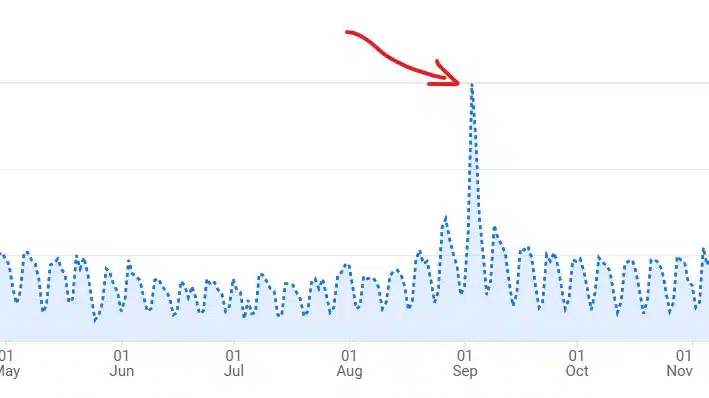The first day of the semester always brings a spike in foot traffic – hallways buzzing, new students finding their way, and campus coming alive. But what’s equally interesting? The spike in website traffic—and how students actually get there.

As I was chatting with one of our student ambassadors today, he mentioned something that made me think. Paraphrasing:
“The website has a lot of useful info, but honestly, it’s kinda overwhelming. My friends just Google what we need instead. Like, if we’re looking for the bookstore, we don’t click around, we just type in ‘College name bookstore’ and go straight there.”
🔍 Instead of navigating the website or using the search function, they trust Google to take them directly to the right page.
Curious to see if this was just anecdotal or a real trend, I pulled up GA4 and Google Console data—and the numbers backed it up.
📌 1/3 of our visitors come directly to our website typing in the URL or using bookmarks (Keep in mind that some ‘Direct’ traffic may also come from unidentified referral sources that Google cannot track.)
📌 Half relies on search engines (primarily Google) to find what they need. Of those who use search engines:
- 1/4 search for the college name (e.g., “Carroll Community College”)
- 2/4 use long-tail branded keywords (e.g., “Carroll Community College catalog” or “Carroll Community College nursing program”)
Students Aren’t Browsing—They’re Beelining
The deeper I looked, the more this behavior made sense. Research by REACH by RentCafe found that when Gen Z knows exactly what they need, they turn to search engines. Their searches are longer – averaging 4.9 words per query.
And then there’s a shorter attention span.
In one interview from REACH study, a Gen Z participant admitted:
“When I search for something online, thousands of results are overwhelming. I have a very short attention span, and I just need someone to tell me the best option quickly.”
They’re not here to browse. They want a direct route to what they need – with minimal effort.
But Wait – What About Social Media Search?
You’ve probably seen the headlines: Gen Z is ditching Google for TikTok search.
And it’s true – 45% of Gen Z prefers social media platforms like TikTok for search queries compared to just 35% of millennials and 20% of Gen X (Forbes Advisor, 2024).
But here’s the nuance we need to pay attention to as marketers (in the search context):
👉 Social media is for discovery. Search engines are for retrieval.
When students are exploring – looking for dorm room inspiration, career ideas, or where to study abroad –social media is their go-to. But when they already know what they need (like the bookstore, course catalog, or financial aid info), they go straight to search.
What This Means for Higher Ed Marketers
✅ Search Engine Optimization (SEO) isn’t just for prospective students—it’s for current students too. If your website doesn’t make key resources easy to find, students won’t dig. They’ll just Google it. And soon, they’ll likely “AI it” – using AI-powered search tools and chatbots to get instant answers. This shift requires us to consider how our content is structured and optimized for these emerging search methods. Are we providing clear, concise answers that AI can easily access and deliver?
✅ Optimize long-tail branded searches. The most-searched pages (catalog, financial aid, portal login) should rank at the top – with clear, relevant content.
✅ If students prefer Google over your internal search bar, prioritize optimizing your content for external search engines rather than trying to redirect this behavior. While a good site search is important, students prioritize speed and convenience. They’re used to the efficiency and habit of using Google and often default to it, even for internal resources. This underscores the importance of a seamless external search experience.
✅ Mobile optimization is key: Students are constantly on their phones. Ensure your website, landing pages, and search results are fully optimized for mobile viewing and interaction. Test your site on various devices to ensure a seamless user experience.
Actionable Takeaways:
- Optimize Branded Search Visibility: Analyze what students are searching for when referencing your institution. Ensure the correct pages appear at the top of search results to create a positive first impression.
- Make SEO a Priority: SEO is not just for attracting prospective students. It’s crucial for current students as well. Prioritize it as a core component of your digital strategy.
- Data-Driven Decisions: Use analytics to understand student search behavior, refine your SEO strategy, and make informed decisions about resource allocation. (Helpful resource: How to implement GA4 & best practices)
- Student-Centric Approach: Combine data analysis with direct student feedback (e.g., a student ambassador program) to ensure you’re meeting their needs and providing a seamless search experience.(Helpful resource: How to launch a successful student ambassador program)
Are you seeing this at your institution?

NEED HELP WITH GA4?
👉 Whether you need assistance configuring GA4, setting up custom dashboards, or analyzing web data for actionable insights, we’ve got you covered.
